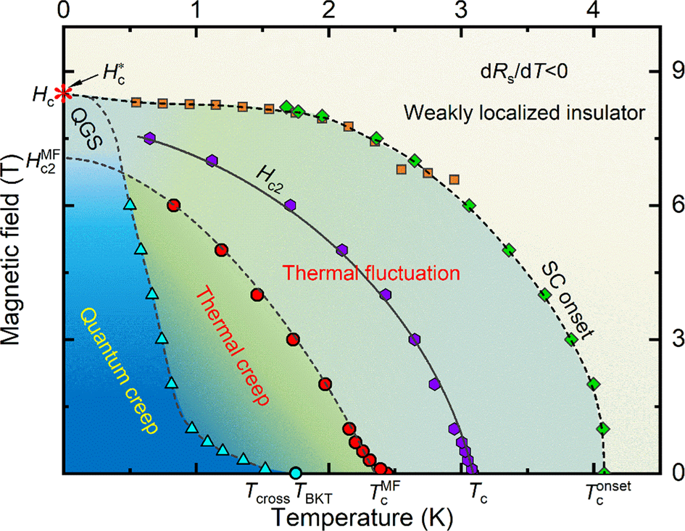NPG Asia Materials ( IF 8.6 ) Pub Date : 2019-12-20 , DOI: 10.1038/s41427-019-0181-3 Chao Zhang , Yunjie Fan , Qiaoling Chen , Tianyi Wang , Xiang Liu , Qi Li , Yuewei Yin , Xiaoguang Li

|
A superconductor–metal transition (SMT) with an unconventional diverging dynamic critical exponent was recently discovered, and it drew tremendous attention because this signature of a quantum Griffiths singularity (QGS) was thought to be a common characteristic of low-disorder crystalline superconductors. However, because the QGS was observed only in limited materials with metallic normal states, the question of whether the QGS exists in other superconducting systems is still unanswered. In this paper, a superconductor–insulator transition (SIT) is observed in TiO thin films with insulating normal states, which offers a more universal platform for investigating the QGS. A thickness-tuned SIT is obtained when the magnetic field is zero. Importantly, a magnetic field-tuned SIT with a diverging dynamic critical exponent, which is direct evidence of a QGS, is observed in TiO thin films with different thicknesses. By constructing a comprehensive phase diagram, it is demonstrated that the critical magnetic field Hc tends to saturate as the temperature approaches 0 K, which is different from the upturn trend of Hc observed in SMT systems and probably due to the weaker Josephson coupling of the locally ordered superconducting islands (rare regions) in a weakly insulating normal state background. The results extend the QGS scenario from only SMT systems to SIT systems, and they provide vital evidence that QGSs are common in crystalline superconducting thin films, which has possible applications in quantum-computing devices.
中文翻译:

具有绝缘常态的TiO超导薄膜中的量子Griffiths奇异性
最近发现了具有非常规发散动态临界指数的超导体-金属跃迁(SMT),并引起了极大的关注,因为这种量子格里菲斯奇点(QGS)的特征被认为是低序晶体超导体的共同特征。但是,由于仅在具有金属常态的有限材料中观察到了QGS,所以仍未回答有关QGS是否存在于其他超导系统中的问题。在本文中,在具有绝缘常态的TiO薄膜中观察到超导体-绝缘体转变(SIT),这为研究QGS提供了更通用的平台。当磁场为零时,获得厚度调整的SIT。重要的是,磁场调谐的SIT具有发散的动态临界指数,在不同厚度的TiO薄膜中观察到了QGS的直接证据。通过构建全面的相图,可以证明临界磁场当温度接近0 K时,H c趋于饱和,这与SMT系统中观察到的H c的上升趋势不同,这可能是由于处于弱绝缘正常状态的局部有序超导岛(稀有区)的约瑟夫森耦合较弱所致。背景。结果将QGS场景从仅SMT系统扩展到了SIT系统,它们提供了重要的证据,证明QGS在晶体超导薄膜中很常见,这可能在量子计算设备中得到应用。











































 京公网安备 11010802027423号
京公网安备 11010802027423号